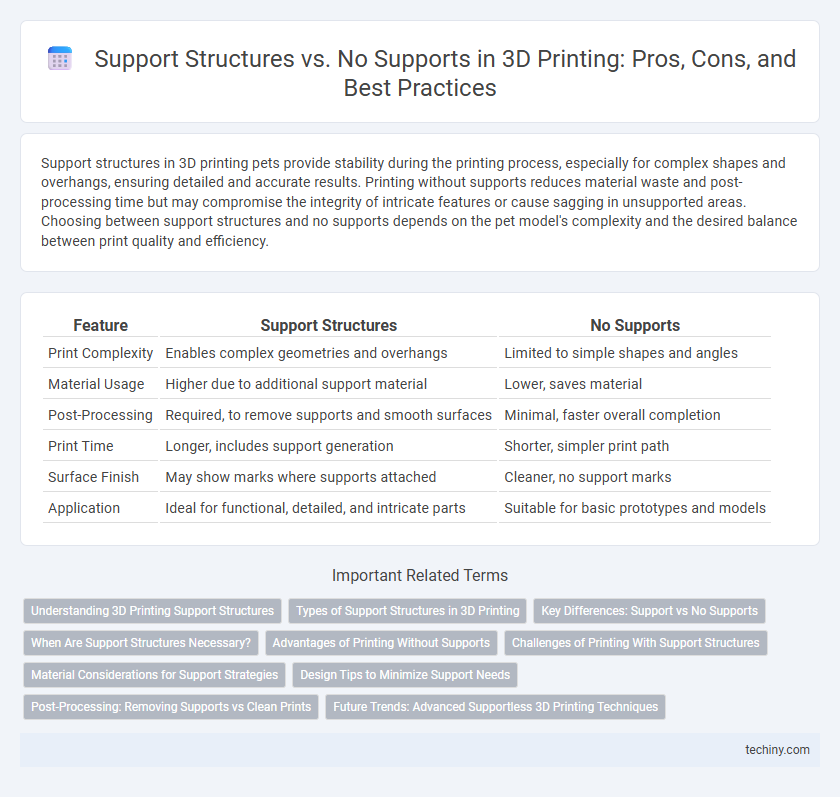Support structures in 3D printing pets provide stability during the printing process, especially for complex shapes and overhangs, ensuring detailed and accurate results. Printing without supports reduces material waste and post-processing time but may compromise the integrity of intricate features or cause sagging in unsupported areas. Choosing between support structures and no supports depends on the pet model's complexity and the desired balance between print quality and efficiency.
Table of Comparison
| Feature | Support Structures | No Supports |
|---|---|---|
| Print Complexity | Enables complex geometries and overhangs | Limited to simple shapes and angles |
| Material Usage | Higher due to additional support material | Lower, saves material |
| Post-Processing | Required, to remove supports and smooth surfaces | Minimal, faster overall completion |
| Print Time | Longer, includes support generation | Shorter, simpler print path |
| Surface Finish | May show marks where supports attached | Cleaner, no support marks |
| Application | Ideal for functional, detailed, and intricate parts | Suitable for basic prototypes and models |
Understanding 3D Printing Support Structures
3D printing support structures are essential for stabilizing overhangs and complex geometries during the printing process, preventing sagging or collapse. Choosing to print without supports requires optimizing print orientation and design to minimize overhangs and ensure structural integrity. Understanding the types of support materials, such as soluble or breakaway supports, enhances print quality and post-processing efficiency in additive manufacturing.
Types of Support Structures in 3D Printing
Support structures in 3D printing are essential for creating overhangs and intricate geometries, with common types including tree-like supports, scaffold supports, and lattice supports. Tree-like supports use minimal contact points to reduce post-processing, while scaffold supports provide robust stability for large overhangs, and lattice supports offer a balance by cradling the model with a grid-like pattern. Choosing the right type depends on the printer technology, material, and complexity of the design, optimizing for print quality and ease of removal.
Key Differences: Support vs No Supports
Support structures in 3D printing provide a scaffold for overhanging features, preventing sagging and ensuring dimensional accuracy in complex geometries. Printing without supports eliminates post-processing time and material waste but risks print failures or imperfections on unsupported overhangs exceeding critical angles. Choosing between support and no-support printing depends on model complexity, material properties, and the printer's capabilities to balance print quality and efficiency.
When Are Support Structures Necessary?
Support structures are necessary in 3D printing when overhangs exceed 45 degrees or parts have complex geometries with bridges and cantilevers that cannot be self-supported during the printing process. Materials like PLA and ABS often require supports to maintain dimensional accuracy and prevent warping or sagging in intricate designs. Removing supports after printing adds post-processing time but ensures higher print quality and structural integrity for detailed models.
Advantages of Printing Without Supports
Printing without support structures enhances surface quality by eliminating post-processing marks and reducing print time through simplified geometry. It also minimizes material usage, lowering costs and environmental impact while decreasing the risk of print failures caused by support removal. This approach is ideal for designs that can be oriented or engineered to self-support, maximizing efficiency and print reliability.
Challenges of Printing With Support Structures
Printing with support structures introduces challenges such as increased material usage and longer print times, impacting overall cost-efficiency. Removing supports can damage delicate features and lead to surface imperfections, requiring post-processing that demands skill and time. Complex geometries often necessitate intricate support designs, complicating print planning and increasing the risk of print failures.
Material Considerations for Support Strategies
Material considerations play a crucial role in deciding between support structures and no-support strategies in 3D printing, as certain filaments like PLA and ABS benefit from supports to prevent warping and ensure dimensional accuracy. Flexible materials such as TPU often require minimal or no supports due to their elasticity, reducing post-processing time and material waste. Selecting the appropriate support strategy also depends on the print's geometry and material adhesion properties to optimize print quality and structural integrity.
Design Tips to Minimize Support Needs
Designing 3D models with angled surfaces below 45 degrees and incorporating chamfers or fillets can significantly reduce the need for support structures during printing. Utilizing bridging techniques and optimizing overhangs helps maintain print quality while minimizing material wastage. Careful orientation of the model on the print bed further decreases support requirements and post-processing time.
Post-Processing: Removing Supports vs Clean Prints
Support structures in 3D printing require careful removal during post-processing, which can add time and risk surface imperfections or damage to the final print. Prints produced without supports often result in cleaner surfaces and faster post-processing, reducing the need for sanding or filling. Choosing no supports relies on optimized print orientation and advanced slicing settings to maintain print quality while minimizing cleanup effort.
Future Trends: Advanced Supportless 3D Printing Techniques
Future trends in 3D printing emphasize advanced supportless techniques that enhance print quality and reduce material waste by eliminating the need for traditional support structures. Innovations in software algorithms and hardware, such as adaptive slicing and multi-axis printing, enable complex geometries to be fabricated without supports, improving surface finish and post-processing efficiency. These developments drive the adoption of more sustainable, cost-effective 3D printing workflows across aerospace, medical, and automotive industries.
Support Structures vs No Supports Infographic

 techiny.com
techiny.com